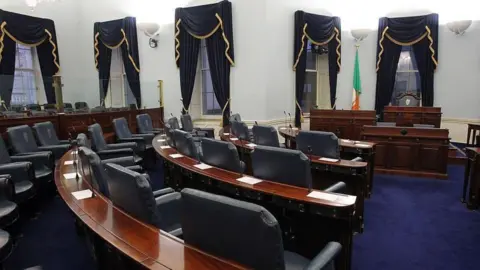Seven women among Seanad Éireann nominees
 Getty Images
Getty ImagesThe leaders of the new Irish coalition government have confirmed 11 nominees to Seanad Éireann (the upper house of the Irish parliament).
The nominations follow last November's general election and the election of the new government in the Dáil (lower house of parliament) in January.
Taoiseach (Irish prime minister) Micheál Martin and Tánaiste (deputy prime minister) Simon Harris have selected a majority of woman for the posts following widespread criticism over the number of women appointed as ministers in the new government.
Seven of the 11 Seanad nominees are woman.
 Getty Images
Getty ImagesThe taoiseach and Fianna Fáil leader Martin selected six nominees - former Limerick mayoral candidate Dee Ryan, former Galway East TD Anne Rabbitte, broadcaster and Louth general election candidate Alison Comyn, outgoing Dublin Senator Lorraine Clifford Lee, Tipperary Councillor Imelda Goldsboro and former Longford-Westmeath TD Joe Flaherty.
The tánaiste and Fine Gael leader Harris has selected five - the well-known RTÉ sports broadcaster Evanne Ní Chuilinn (who has now resigned from her role at the national broadcaster), outgoing Donegal Senator Nikki Bradley, Cork Councillor Noel O'Donovan, Councillor Garrett Scahill from Roscommon, and Councillor Manus Boyle from Donegal.
The are set to join the 49 elected senators in the upper house, among them former Northern Ireland Economy Minister Conor Murphy.
This female majority among the nominees contrasts sharply with the female representation in the new Irish government.
Twelve of the 15 senior ministers are men while 17 of the 23 junior ministers are also men.
Seanad Éireann comprises 60 Members who are elected to five vocational panels, from two university constituencies or nominated by the government leaders.
What does the Seanad do?
The main function of Seanad Éireann is to vote on or amend legislation.
Bills can start and end in the Seanad as well as in the Dáil.
However, the Dáil has the power to override the Seanad's rejection of a bill.
The Seanad can also take part in the removal of the president from office or a judge of the Supreme Court, Court of Appeal, or High Court.
It also has input on declaring a state of emergency.
How is the Seanad elected?
This is often noted as the most confusing part of the Seanad operation.
The Seanad election must take place up to 90 days after Dáil Éireann has dissolved.
This means that the new Dáil is formed before the Seanad election.
Forty-nine of the Seanad's 60 members are elected, and 11 are nominated by the taoiseach.
However, not everyone in Ireland can vote for the 49 elected members.
Forty-three are elected from panels of candidates representing specified vocational interests.
The panels are cultural and educational, agricultural, labour, industrial, and commercial and administrative.
Candidates for panels are selected by nominating organisations or by members of the incoming Dáil or outgoing Seanad.
The following people may vote in an election of panel members:
Members of the incoming Dáil
Members of the outgoing Seanad
Members of county councils and city councils
The remaining six members are elected by university graduates of Trinity College Dublin and the National University of Ireland.
